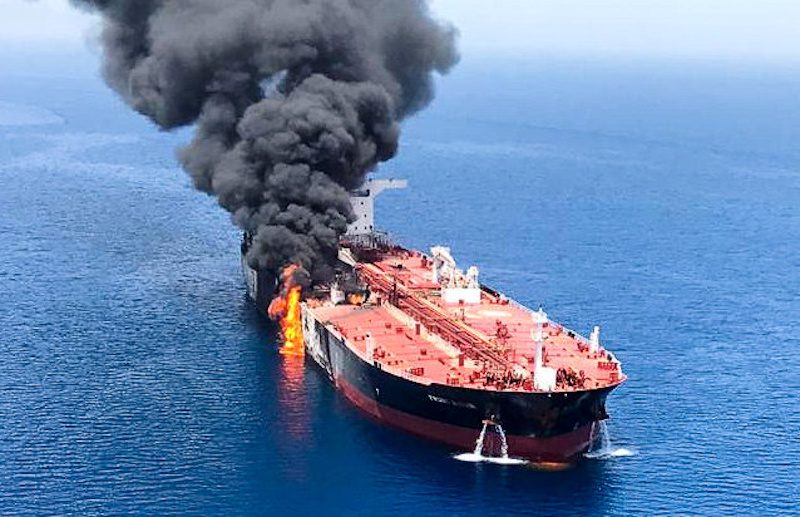An oil tanker is seen after it was attacked at the Gulf of Oman, June 13, 2019. ISNA/Handout via REUTERS
By Sal R. Mercogliano – The June 13, 2019 attacks on MV Front Altair and MV Kokuka Courageous, following the assault on four tankers at the anchorage of Fujairah on May 12, has raised the specter of a naval confrontation between Iran and the United States. This method of assault and conflict between these two nations is not new. The United States and Iran were embroiled in an undeclared naval war from 1987 to 1988. The genesis for the largest naval battle fought by the U.S. Navy since the Second World War resulted from the war waged by Iran and Iraq against tankers transiting the Persian Gulf. Today, the Middle East war being waged between Iran, Saudi Arabia, and their proxies eerily look like the situation at the start of the First Tanker War.
This initial struggle began after Iran and Iraq went to war in September 1980. To wage total war against each other, they aimed at their economic vulnerabilities after the fighting deadlocked along their border. Iran exported most of its oil via tankers, so it was vulnerable to attacks on its commercial fleet and those from around the world loading petroleum from their terminals. In 1981, Iraq targeted ships in the northern end of the Persian Gulf. In that first year, only five ships were hit with another 22 in the following year, and 16 in 1983. In March 1984, Iraq stepped up their assault and started to target tankers further down the Gulf, particularly those vessels using the large Kharg island terminal. This drew a response from Iran, but since Iraq used pipelines to ship their oil, Iran aimed at Iraq’s allies, Kuwait and Saudi Arabia. By the time the war peaked in 1987, a total of 451 ships were hit.
The assaults in 1987 witnessed ships from around the world suffering damage, with tankers registered in Liberia, Panama, Cyprus, Greece, Malta, Kuwait, Saudi Arabia, Turkey, Norway, Singapore, the United Kingdom, Japan, Republic of Korea, Federal Republic of Germany, India, France, Spain, Bahamas, Denmark, Pakistan, Italy, Qatar, Philippines, Soviet Union, Maldives, Netherlands, Hong Kong, China, the UAE, Yugoslavia, Australia, Romania, and Burma taking hits. That same year, two ships from the United States were struck and these marked the beginning phase of American participation in the escorting of reflagged Kuwaiti tankers.
The style of attacks employed by the Iraqis largely involved their aircraft flying along the shore of Saudi Arabia and the Persian Gulf. Once they reached a designated location, they headed into the Gulf and launched air-to-surface missiles, such as French Exocets at suspected Iranian tankers. It was one of these operations that led to the assault on the American frigate Stark on May 17, 1987, resulting in the death of 37 sailors and wounding another 21.
Prior to the attack, the government of Kuwait sought a nation to escort their tankers. Kuwait suffered eight ships damaged and without an adequate navy, they approached both the United States and the Soviet Union for protection. The United States initially hesitated but fearing the inroads of the Soviet Union they agreed and the first convoy of reflagged Kuwaiti tankers, registered in the US, sailed from Kuwait shortly after the Stark incident. As the convoy sailed southward they encountered Iranian opposition. The Iranians used a variety of tactics in their attacks, from gunfire, to missiles, to mines. It was the latter that the reflagged tanker MV Bridgeton struck on her transit. The Navy escort lacked any minesweeping or detection gear and after assessing the damage to Bridgeton, the convoy continued outward bound, with the supertanker in the lead, and the Navy vessels following in her wake. By the end of the year, the Navy escorted a total of 56 ships in 23 convoys.
Later that year, Army AH-6 special operations helicopters operating from a US Navy frigate witnessed a small vessel, Iran Ajr, laying mines. They assaulted the vessel and it was subsequently captured by Navy SEALS and ten mines were found on board. On October 16, the American tanker MV Sea Isle City at anchor off Kuwait was struck by an Iranian land-based Silkworm missile; eighteen of her crew were injured. Due to these provocations, the US Navy assaulted several Iranian oil platforms near Bahrain. Early the next year, on April 14, the frigate Samuel B Roberts struck an Iranian laid mine and suffered ten casualties. Excellent damage control saved the vessel and the United States responded with Operation Praying Mantis, sinking an Iranian frigate and destroying several oil platforms in the southern gulf.
The end to the Tanker War came not because of American action, but the Iraqis and Iranians brokering a cease fire between the two. The calm did not last long as Iraq invaded its neighbor to the south in August 1990 and led to a massive response by the world. The US Navy and other warships swarmed the Persian Gulf and remained there to interdict trade to Iraq until the subsequent war in 2003.
These most recent attacks follow others, including assaults against shipping by Houthi rebels in the Bab-el-Mandab. The latest provocation raises the question, is this the start of a new Tanker War and will the United States Navy intervene as it did in the First Tanker War?
First, it will be necessary to understand why Iran, as the alleged perpetrator for these attacks, is undertaking these operations. The objective of the attacks in May and June did not appear to aim at the destruction of their intended targets. Damaging of the vessels will not hinder the flow of oil out of the Gulf, although even the First Tanker War did not prevent it, but it did significantly slow down the flow. Second, the United States Navy did not enter the conflict until it was attacked and asked by the Kuwaitis to participate. All the ships attacked recently were foreign-flagged and owned. Even during the height of the pirate attacks off the East Coast of Africa, while US Navy warships patrolled the shipping lanes, they did not intervene in any of the captures until the American-flagged MV Maersk Alabama was seized.
One can expect to see American warships continue their presence in the area and render assistance as was the case with the most recent attacks. Based on the history of the last Tanker War, the current situation is well below the threshold that led to previous American intervention. However, situations change, and the current relationship between the leaders of the countries, the declaration of the Iranian Revolutionary Guard as a terrorist organization, and Iran’s effort to develop nuclear weapons, makes the chance of potential for conflict greater. In the past, the U.S. Navy restricted its escorts to ships of the U.S. merchant marine. Not since 2015, when MV Maersk Kensington was harassed by Iranian naval craft, has there been a call for such actions. These new attacks may just be the prelude to a new Tanker War in the Persian Gulf.

 Join The Club
Join The Club











